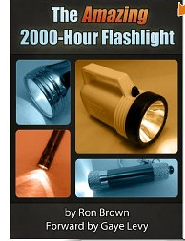This post is by Bernie Carr, apartmentprepper.com
I purchased a copy of The Amazing 2000-Hour Flashlight by Ron Brown. It’s a manual that shows you how to add a 30-cent resistor to a $5 flashlight, to create a light that will run for 2000 hours on the same battery. The e-book contains step by step instructions and includes illustrations. You can’t buy such a light from a store; you have to make it yourself.
I first heard about the author, Ron Brown through his DVD, Lanterns, Lamps and Candles. After learning from his DVD, I went on to experiment with making emergency lights from common household items and they were all super cheap and easy. The e-book’s Foreword was written by Gaye Levy, who runs one of my favorite blogs, Backdoor Survival. With two trusted writers, I figured this book is sure to be a treasure trove of information.
Being the inquiring mind, I asked Ron Brown a question that I am sure comes up:
APT PREPPER: The book description indicates “using illumination for 2000 hours” – how many lumens would you estimate the light to be?
RON BROWN: You’ve asked an excellent question but not a simple one to answer. So I’m going to quote from the book itself (sans illustrations).
“When I first added a 150-ohm resistor to a flashlight, I was concerned about how much light it would produce. So I compared my newly modified light to a variety of other flashlights I already owned.
“In preparing a sequel to Lanterns, Lamps & Candles that would address electric emergency lighting (a future project, as it turns out), I accumulated a fair assortment of flashlights, old and new, borrowed and blue.
“Comparing them, I found that the Eveready 5109LS with a 150-ohm resistor was right down the middle, neither the brightest nor the dimmest of what I had on hand. So, even with the resistor in place, it’s fair to say that the light output is “good.” Not great, I’ll be the first to admit, but good.
“Now, what can I use as a cutoff point, a minimum, a threshold, to say that it’s NOT good anymore? Here’s where it gets sticky.
“Flashlights are commonly rated in “lumens” and most lights provide that info on the label. The Eveready 5109LS does not. Online, however, various sellers (e.g. Best Buy, Walmart) state that the 5109LS outputs 25 lumens.
“What the 5109LS wrapper does display is a little clock icon that says ‘FL 1 Standard 65h’ (meaning 65 hours). ‘FL 1’ stands for ANSI/NEMA FL 1 – Flashlight Basic Performance Standard. In that standard, run time is defined as ‘the continuous time lapsed from the initial light output to when the light is at 10% of the initial output.’
“So the FL 1 standard uses circular reasoning. A flashlight is measured in terms of itself. If the 5109LS starts out at 25 lumens, when it reaches 2.5 lumens its run time is deemed to have expired. (According to Eveready, that’s 65 hours.)
“I would argue that we need a fixed standard of comparison, not a moving target. When I’m trying to compare light output and battery life using a 56-ohm resistor versus a 150-ohm resistor versus no resistor at all, a run-time benchmark defined as ‘10% of wherever you started’ is useless.
“So I picked a light that supplies, in my opinion, a minimum threshold of useful light. It’s a keychain light, the Maglite Solitaire. It’s been around since 1988 and kicks out a blazing 2 lumens. Count ’em. Two.
“Although the two-lumen Solitaire will not inspire Tarzan-yells and chest beating, it does produce sufficient light to be useful. You’ll be able to find your way to the privy at midnight. It’s a practical standard by which to compare various flashlight designs. And it’s widely available; Walmart carries it.
“I bought a new Solitaire. The Solitaire’s blister-pack contained a Duracell alkaline battery in addition to the flashlight. I swapped out the Duracell for a new Energizer Ultimate Lithium battery. I removed the lithium battery from the Solitaire between tests.
“I used a pass/fail test. As long as the flashlight being tested was visibly brighter than the brand new Solitaire, I judged the test-light as ‘passing.’ I would waggle my finger at the test-light and say, ‘Keep on trucking.’
“When the light being tested had dimmed to the point of being MERELY EQUAL to the brand new Solitaire, I judged the test-light to have ‘failed.’ I would then jerk my thumb and yell at the test-light, ‘You’re outta here.’
“That was my standard. That’s where the 2000 hours came from.
“You might well ask, of course, ‘How did you determine visibly brighter?’
“In answer, the simplest test I found was to stand in a dark room with the light being tested in one hand and the Solitaire (the control or standard) in the other and shine the lights in quick succession, one after the other, at an analog wall clock with a sweep second hand, twenty feet away. If you try it, you’ll discover there really isn’t much question about which one best illuminates the clock face.”
This response shows how thoroughly this book is written.
I have read through it and found that the materials are very easy to find, and the instructions are easy for me to figure out. I am going out to get the parts and assemble a couple of these 2000 hour lights for myself. Having an emergency light that’ll last for 2000 hours is certainly a money-saver for apartment dwellers and homeowners alike. This information is a bargain at 99 cents and I highly recommend this e-book.
© Apartment Prepper 2013



Oh wow. That’s really cool. Should get my hands on it.
It would make for a great experiment to try out the instructions.